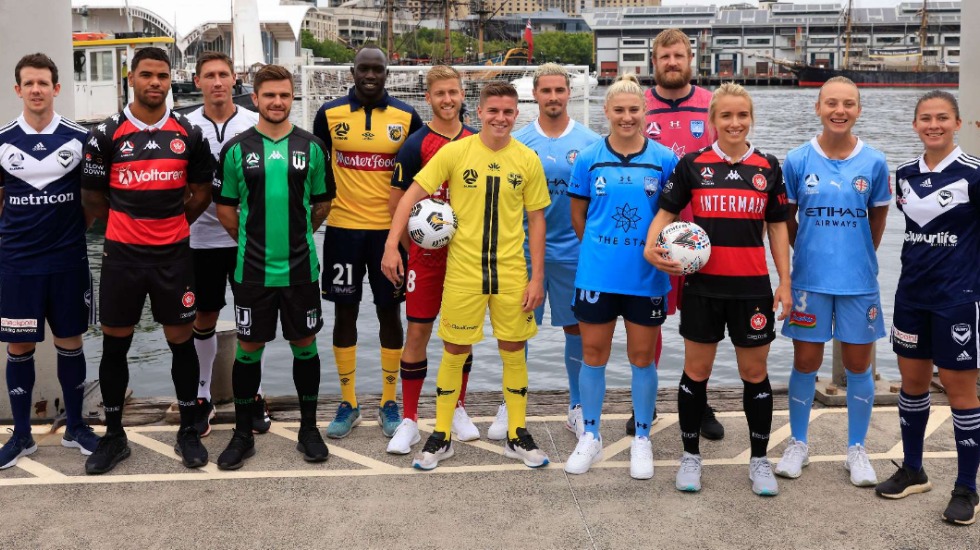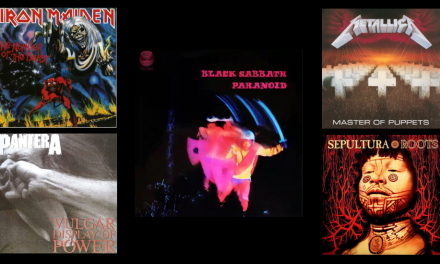A-League Men’s and Women’s players posing for the cameras ahead of a crucial season for domestic soccer.
Every year us football types seem to trot out the same trope.
“The most important season ever” has become such a part of our lexicon, it’s difficult to remember when we celebrated the start of a new campaign, just for its own sake.
This has long been the reality of a sport living from hand to mouth. Managing crisis. The endless search for the silver bullet, while struggling just to survive.
Is this year any different? Perhaps.
For sure, issues persist. For starters, the ongoing saga of sexual abuse allegations surrounding the Matildas could yet derail arguably the nation’s most popular sporting team.
The game remains chronically underfunded – which explains, in part, the Socceroos’ late fadeout against Saudi Arabia last week.
While the ‘Roos arrived in dribs and drabs via scarce commercial flights (some touching down as late as Monday or Tuesday), the Green Falcons had been safely ensconced in camp in Sydney for a full five days, after having jetted in on a private charter from Riyadh. The number of suitable football facilities (stadiums in particular), are also a problem.
And then there’s the issue of the “closed” league that might be the norm for most sports in Australia, but which is anathema to many football fans. The proposed National Second Division – first proposed over four years ago – is frustratingly, still no more than a concept. Without a connected pyramid, some football fans simply refuse to engage with the senior competition.
That internal pressure (and the truth is, some would prefer to see the A-Leagues fail than exist on the current terms), is exacerbated by outside hostility.
If football types are guilty of rehashing the “most important season ever” line, then they surely have nothing on the “football is full of divers, hooligans and boring draws” brigade – many of whom are in the full-time employ of influential media outlets. With the game having exited from its long association with the dominant player in that realm, News Corp, coverage is likely to be sporadic, and neutral in tone at best.
Yet this is where the new TV deal with Network Ten and Paramount Plus (for transparency’s sake, my current employers), could be worth its weight in gold.
Ten has not just pumped money into a five-year contract, it has also taken a stake in the league itself. It is hugely invested – literally – in the future of football in Australia, and unlike its predecessor, there is a much shorter pecking order in terms of its other properties. Football will be a priority, not an afterthought.
We are already seeing this through the integration of football content into shows like The Project, Master Chef and Have You Been Paying Attention? After the iconic Melbourne Cup race had finished, Ten cut immediately to a promo of the new A-Leagues campaign. It’s the sort of exposure football has long craved.
PLEASE HELP US CONTINUE TO THRIVE BY BECOMING AN OFFICIAL FOOTYOLOGY PATRON. JUST CLICK THIS LINK.
Its streaming service – Paramount Plus – appears to be competitively priced, and should reap the benefit of the advances in technology, providing enough customers subscribe.
Another game-changer could be the long-awaited private investment – rumoured to be a deal with Silicon Valley giant, Silver Lake, worth up to $130 million, which is believed to be imminent.
Should it eventuate, a large chunk of that investment will go towards the new online “hub” called KeepUp, which launched just last week. It promises a one-stop shop for football news, features, videos and written articles for the game, not just in Australia, but worldwide.
In effect, this is the modern day online “barker” channel for the coverage and the game, in the way Sky Sports News was (and to an extent, still is) for football in the UK.
This has kick-on effects for the football economy. Football-specific journalists had been largely removed from the erstwhile mainstream media – now, the likes of Joe Gorman (author of The Life & Death of Australian soccer) are returning to contribute, and a new generation such as Christina Trajceska, are being given opportunities.
A variety of voices representing the broad spectrum of the game are vital to amplify the conversation around football. A word of caution though: KeepUp’s paymasters – the APL, who now run the leagues – must be mindful of editorial interference. If recent experience has taught us anything, it’s that sanitised coverage of the game quickly has fans logging off.
As ever, the most important bit will be on the pitch.
To this end, the A-League (Men’s) has acquired a sprinkle of magic dust in the shape of Daniel Sturridge, formerly of Liverpool, Chelsea, Manchester City and England. If he stays fit, copes with the summer heat, hard pitches and wearying travel, he could have an impact not seen since Alessandro del Piero. A few others elsewhere wouldn’t go amiss, but in themselves, marquees are not the panacea.
The long game is the conversion of hearts and minds. Convincing the Liverpool or Man United fan that the A-Leagues are worthy of his/her time and money. Cajoling at least some of the near two million playing base to give the local comp a go. And bringing those dyed-in-the-wool fans of clubs outside the senior competition inside the tent, by removing the glass ceiling to the pyramid underneath.
It’s a complicated landscape, and it’s why with football in Australia, there’s never a guarantee. The next crisis is rarely far from the horizon.
However, this time 12 months ago, the professional game was just grateful to have lived to see another day. Things look brighter now – but yes, with all of the above in play, it’s still “the most important season ever”.
Sorry, but it’s true.











